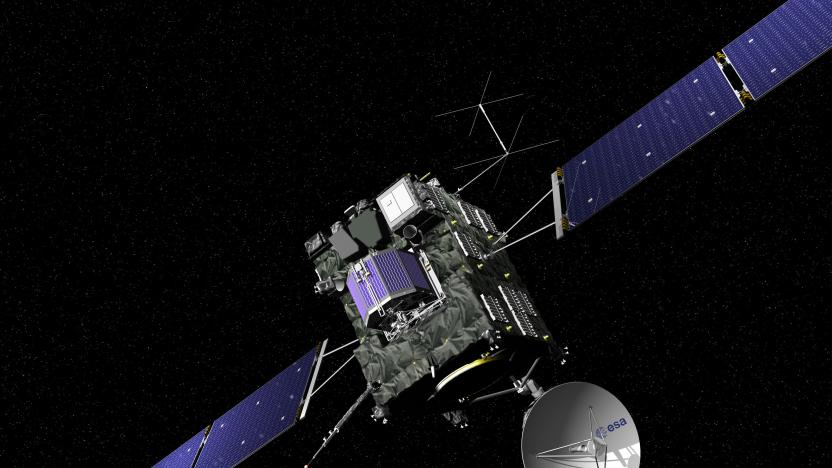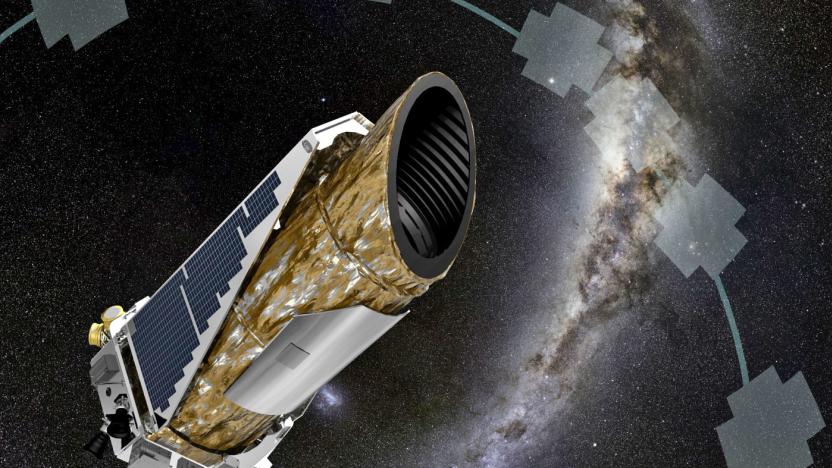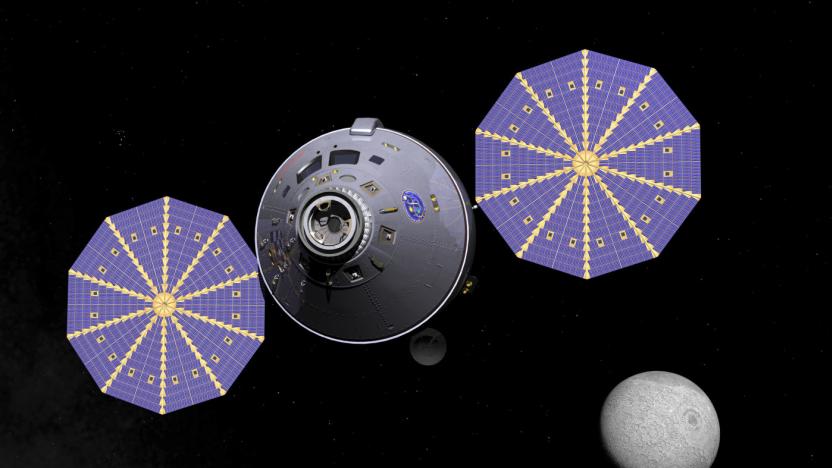jpl
Latest

Juno's misbehaving engine means a change of plans around Jupiter
Three months ago, the Juno probe ended a years-long journey when it settled into orbit around Jupiter. Everything's just peachy with Juno's cameras -- as evidenced by these magnificent photos -- but it turns out its primary Leros 1b engine is having trouble. In preparation for a burn that would put Juno into its final orbit around the gas giant, the team at NASA's Jet Propulsion Laboratory punched up a sequence of commands late last week and saw (via telemetry) that a pair of helium check valves weren't working correctly.

Rosetta probe's love affair with a comet ended predictably
Goodbye, Rosetta. After 12 years of getting up close and personal with Comet 67P, your service has come to an end. At approximately 7:19 am Eastern the spacecraft descended upon the comet one last time, snapping pictures and analyzing gases before crashing into its final resting place, according to NASA's Jet Propulsion Lab. Reuters reports that scientists in the control room clapped and hugged after screens indicated a loss of communication. Rosetta followed the comet around for over 6 billion kilometers since 2004. Shine on, you crazy diamond.

Curiosity awakens from nap to resume full operations
Curiosity is back to work on Mars after it shut itself down due to a software glitch on July 2nd. Even though tech support for the rover is nearly 60 million miles away, NASA scientists weren't too worried about the issue. As suspected, the cause was found to be a "software mismatch in one mode of how image data are transferred on board." However, other means are available to transmit image data, so the team powered up the rover on July 9th and will simply avoid using the problematic mode.

How to watch NASA's Juno spacecraft enter Jupiter's orbit
NASA launched its Jupiter-exploring Juno spacecraft on August 5, 2011, but thanks to some patriotic timing, it's arriving at the gas giant today on July 4th. That'll give space fans some additional fireworks, as NASA and JPL will be broadcasting the crucial orbit insertion starting at around 10:30 PM ET. If all goes well, the craft will fire its main engine for 35 minutes and scrub 1,212 mph from its current 37,000 mph velocity. That'll give it just the right speed to be captured into a 53-day orbit around the planet.

Juno: An inside look at NASA's mission to Jupiter
Juno is going where no spacecraft has before. NASA's solar-powered ship was launched five years ago, sent on a mission to study Jupiter, the largest gas globe in our solar system. Now, after almost a couple thousand days on course, it is on track to arrive at Jupiter on the evening of July 4th to scan, measure, study and photograph the planet. On a recent trip to the Jet Propulsion Laboratory (JPL) headquarters in Pasadena, I caught up with lead project scientist Steve Levin for a rundown of the mission and the specific event that could potentially uncover the mysteries of our entire solar system.

NASA is building the next Mars rover in mixed reality
I poked my head inside NASA's latest Mars rover. During a mixed-reality demonstration at the Jet Propulsion Laboratory (JPL) in Pasadena, as soon as I strapped on a HoloLens, a vibrant holographic vehicle popped up in front of me.

ICYMI: Barely hoverbiking, new hair dryer tech and more
#fivemin-widget-blogsmith-image-698312{display:none;} .cke_show_borders #fivemin-widget-blogsmith-image-698312, #postcontentcontainer #fivemin-widget-blogsmith-image-698312{width:570px;display:block;} try{document.getElementById("fivemin-widget-blogsmith-image-698312").style.display="none";}catch(e){}Today on In Case You Missed It: YouTuber Colin Furze teamed up with Ford to build a working hoverbike within just a few weeks, from his shed. It runs off of two diesel engines so granted, it's probably not the most mass-production friendly item, but does beg the question: What's holding everyone back, then?

Climate change is now affecting how the Earth moves
Researchers at NASA's Jet Propulsion Laboratory have found that climate change is now affecting the way that the Earth moves. The team found that, as the last century has progressed, the "wobble" that our planet makes as it travels has shifted. A hundred years ago this movement -- called polar motion -- was tilted in favor of Canada, but has now moved in the direction of the UK. In an of itself, the shift won't cause any damage, but the fact that climate change is now having this sort of effect should cause everyone to get nervous.

NASA's Kepler spacecraft is in 'emergency mode'
NASA's Kepler space telescope was supposed to be continuing its K2 extended mission to hunt down hidden exoplanets, but now scientists say the spacecraft is in trouble (again). While trying to make regularly scheduled contact on Thursday engineers found that it is operating in "emergency mode" and are focused on trying to recover it. That's a bit tricky however, since it's almost 75 million miles away from Earth, and it takes 13 minutes for signals to make a round trip.

NASA's resurrected telescope seeks wandering planets
NASA is kicking off a search for free-spirited exoplanets as part of the Kepler space telescope's extended K2 mission. It's an impressive quest for an instrument that was all but written off several years ago because of damage to its control wheels. NASA managed to stabilize the device using radiation pressure from the sun and it's been spotting exoplanets, stars and galaxies ever since. Now, the space agency wants to use the device to survey millions of stars in the Milky Way galaxy looking for signs of "wandering" exoplanets with no companion star.

NASA's flying methane meter built for Mars finds work on Earth
Just as new military technologies often trickle down to civilian uses, a high-tech methane detector originally developed to detect gases on Mars has found a new role here on Earth. NASA's Jet Propulsion Lab built the the Open Path Laser Spectrometer (OPLS) and have affixed it to a standard quadcopter. And given that greenhouse gas emissions are currently at a 30-year high, according to the UN, this pipeline inspector can't come soon enough.

New Horizons spots signs of a former lake on Pluto
The New Horizons probe isn't just revealing details of Pluto's highest heights... it's also uncovering some of the dwarf planet's hidden history. NASA has published an image form the spacecraft showing evidence of a former frozen lake. The remnants are relatively small (20 miles across at their widest), but the surrounding channels hint that the lake held liquid nitrogen at some point in the distant past. While we'll need more data to draw any firm conclusions, this suggests that Pluto was considerably livelier "millions or billions" of years ago -- it wasn't the wasteland it appears to be today.

NASA picks solar power candidates for deep space missions
NASA is going to need solar power if it wants to keep its future deep space missions running, and that means getting someone to build that light-gathering technology. Fortunately, the agency has some partners lined up. It just picked four solar power technology proposals that could find their way into spacecraft traveling as far as Mars. The outfits negotiating deals are definitely ones you'll know -- ATK, Boeing, Johns Hopkins University and NASA's own Jet Propulsion Laboratory are all developing systems that collect solar energy in the unforgiving conditions beyond Earth.

An interview with one of NASA's Curiosity Rover engineers
With his Elvis haircut, his fondness for cowboy boots and the way he'll launch into soliloquies about big ideas like how to bend humanity toward collective self-improvement, Adam Steltzner might come off at first as some kind of hipster philosopher. That's one of the things that makes him such a memorable ambassador for NASA, his employer. Steltzner is in fact an engineer with an improbable combination of geek cred and California cool who this October will have spent 25 years working at NASA's Jet Propulsion Laboratory. He looks like a rock star -- plays bass guitar, in fact -- and can forcefully insist on humanity's imperative to explore the stars and to press against the limits of the known universe with little prompting.

ICYMI: Spacey HoloLens use, spy submarines and more
#fivemin-widget-blogsmith-image-905675{display:none;} .cke_show_borders #fivemin-widget-blogsmith-image-905675, #postcontentcontainer #fivemin-widget-blogsmith-image-905675{width:570px;display:block;} try{document.getElementById("fivemin-widget-blogsmith-image-905675").style.display="none";}catch(e){}Today on In Case You Missed It: DARPA is about to start testing an autonomous submarine called Sea Hunter, designed to find and trail larger submarines for weeks at a time.

Juno sets distance record for solar-powered spacecraft
Aided by its enormous solar array, NASA spacecraft Juno has set a record as the most distant solar-powered space explorer. The four ton "armored tank" craft hit 493 million miles yesterday on its way to Jupiter, passing Rosetta's 492-million-mile mark. With a 30-foot-long array and 18,698 solar cells, it's able to profit from what little sunlight hits it. "Jupiter is five times farther from the sun than Earth, and the sunlight that reaches that far out packs 25 times less punch," said Juno project manager Rick Nybakken.

NASA sidelines its next Mars Rover mission indefinitely
NASA announced on Tuesday that it has cancelled the upcoming March, 2016 launch of its next Mars Rover, the InSight mission, after realizing it would be unable to fix a busted, French-built seismological instrument in time for liftoff. Unfortunately, due to the relative orbits of Earth and Mars, we won't have another suitable launch window for at least 26 months after that -- aka, May 2018.

I found a secondhand telescope, now what?
It's amazing what you can find on the streets of San Francisco. No, the actual city streets, not the '70s cop drama starring Michael Douglas. I recently came across a scavenger's treasure in the city's Sunset neighborhood: a fully operational Meade NG-70 Altazimuth Refractor Telescope. It was just sitting there on the curb with a handwritten note simply stating "Free" taped to its barrel. Now, I'll tell you, I'm not much of an astronomer -- inasmuch as I have never used (even touched) a telescope or ever had much interest in learning. The idea of standing around outside in the dark, fiddling with dials always seemed too much hassle to make very distant sparkly objects to appear slightly larger. But what I am also not is a sucker -- and a free telescope is a free telescope -- so into my car's trunk it went.

The dark side of Rosetta's comet is icier than expected
The comet that the European Space Agency's Rosetta spacecraft has been chasing around the sun has a dark side. No, 67P isn't hiding any terrible secrets -- the southern hemisphere literally faces away from the sun during most of its 6.5-year-long solar orbit. Until recently, none of the cameras aboard Rosetta have been able to image it due to that utter lack of light, except for one -- the MIRO microwave instrument. NASA scientists behind the device have released a report on their observations, and lead author Mathieu Choukroun said "these unique data are telling us something very intriguing about the material just below its surface."

NASA's trippy Ceres map shows what the dwarf planet is made of
No, you're not looking at an artist's watercolor impression of the Moon. That's NASA's false-color map of Ceres, generated using a mix of infrared and visible light filters onboard the Dawn spacecraft currently orbiting the dwarf planet. The resulting psychedelic freakout isn't just for show, of course. The surface temperatures reflected in those colors give scientists an idea of both Ceres' mineral contents and the age of its many craters and ridges. Reddish hues reveal materials that reflect infrared light, while green highlights spots that are much brighter than usual. Even if humanity never touches down on the planet's surface, you'll eventually know what you could expect from a first-hand visit. [Image credit: NASA/JPL-Caltech/UCLA/MPS/DLR/IDA]








